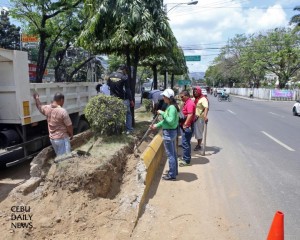Seven Indian trees earth-balled, relocated to Cebu City nursery

The Indian trees were still standing at the traffic island along Escario Street when Cebu City Hall personnel began work on reducing the island’s width in order to ease traffic congestion there. (CDN PHOTO/ LITO TECSON)
About seven Indian trees that used to stand in the center of Escario Street near the Provincial Capitol are gone.
They were uprooted from the center island and transferred as part of the “earth-balling” of nearly 20 trees along with bougainvillea shrubs last week, said Arlie Gesta, administrator of the Cebu City Parks and Playgrounds Commission.
While Gesta said it wasn’t necessary to secure an earth-balling permit from the Department of Environment and Natural Resources (DENR-7) since the trees were “ornamental plants” used for landscaping, the agency thought differently.
DENR-7 spokesman Eddie Llamedo said the unauthorized cutting of the Indian trees violated Presidential Decree 953 which “penalizes the unauthorized cutting, destruction, damage and injuring of certain trees, plants and vegetation.”
The earth-balling of the Indian trees is part of Cebu City Mayor Michael Rama’s plan to reduce the size of the traffic island along Escario Street near the Capitol area to ease traffic congestion there.
Concrete center dividers in other portions of the street were already demolished and asphalted over to provide more space.
Correct procedure
“We followed the correct procedure of earth-balling. We started pruning the trees last Tuesday and started the actual transfer on Friday,” Gesta told Cebu Daily News.
The trees were 10 years old, he said. Right now, the trees are in a city-owned nursery in Oprra in barangay Kalunasan.
Gesta said the city didn’t have to spend for the earth-balling of the trees since they have the labor and equipment for the undertaking.
He said it cost the city P4,000 to earth-ball the seven Indian trees.
Cultivated
Of that amount, the P3,000 was spent for labor and manpower costs while the P1,000 covered the transport of the trees.
Before they were pruned, the 15-foot Indian trees towered over the center of Escario Street.
After the pruning, the trees were transported to the city’s nursery in Kalunasan, Gesta said.
“The first step in proper earth-balling is to trim the trees. The second step is digging a hole surrounding the tree. And third is the actual pulling out,” Gesta said. Indian trees are native to India and Sri Lanka.
These were recently introduced to the Philippines and have become popular and widely cultivated throughout the country.
It can grow to heights of 15 meters and can be used as a natural fence but not to provide shade, according to an article about the Indian trees in Alabang Hills in the website ManilaOldTimer.net.
Expertise
Gesta said the Cebu City government can also earth-ball the remaining trees along S. Osmeña road.
But a Cease-and-Desist Order (CDO) is in effect for any earth-balling in the area where the Department of Public Works and Highways in Central Visayas (DPWH-7), through a private contractor, is concreting the road.
“We have the technical expertise, manpower and equipment to do the earth-balling in S. Osmeña Road. We can do it. Maybe we will just need some help with the vehicles when transporting the trees,” Gesta said.
There are 20 remaining trees in the traffic island on S. Osmeña Rd., most of which are Fire trees. Rama and the Cebu City Council have both called on the DENR-7 to lift the CDO in the area.
Changes
In earth-balling the Indian trees, Gesta said it wasn’t necessary to secure a Special Tree Cutting Permit (STCP) from the DENR-7 since these were “ornamental plants” used for landscaping by the city.
“For practicality, if you were to landscape, do you still need to ask permission from the DENR? We were the ones who planted them and landscaped them. If we have changes, we should be the ones to decide,” he said.
But Llamedo said even ornamental plants and trees are covered by STCP because the trees are located in a public place.
“This includes government offices, hospitals, schools and roadsides. Even ornamental trees like Indian trees still need a permit,” Llamedo said.
He said based on records of the DENR’s Community Environment and Natural Resources Office (CENRO) Cebu City, there was no STCP or earth-balling permit or even a request received by their office from the city government.
Llamedo said this violated Presidential Decree 953. “We will have that investigated by CENRO Cebu City by Monday (today),” he said.
Related Stories:
Are remaining trees along S. Osmeña Road left for dead?
Rama backs earthballing of trees on S. Osmeña
Disclaimer: The comments uploaded on this site do not necessarily represent or reflect the views of management and owner of Cebudailynews. We reserve the right to exclude comments that we deem to be inconsistent with our editorial standards.
